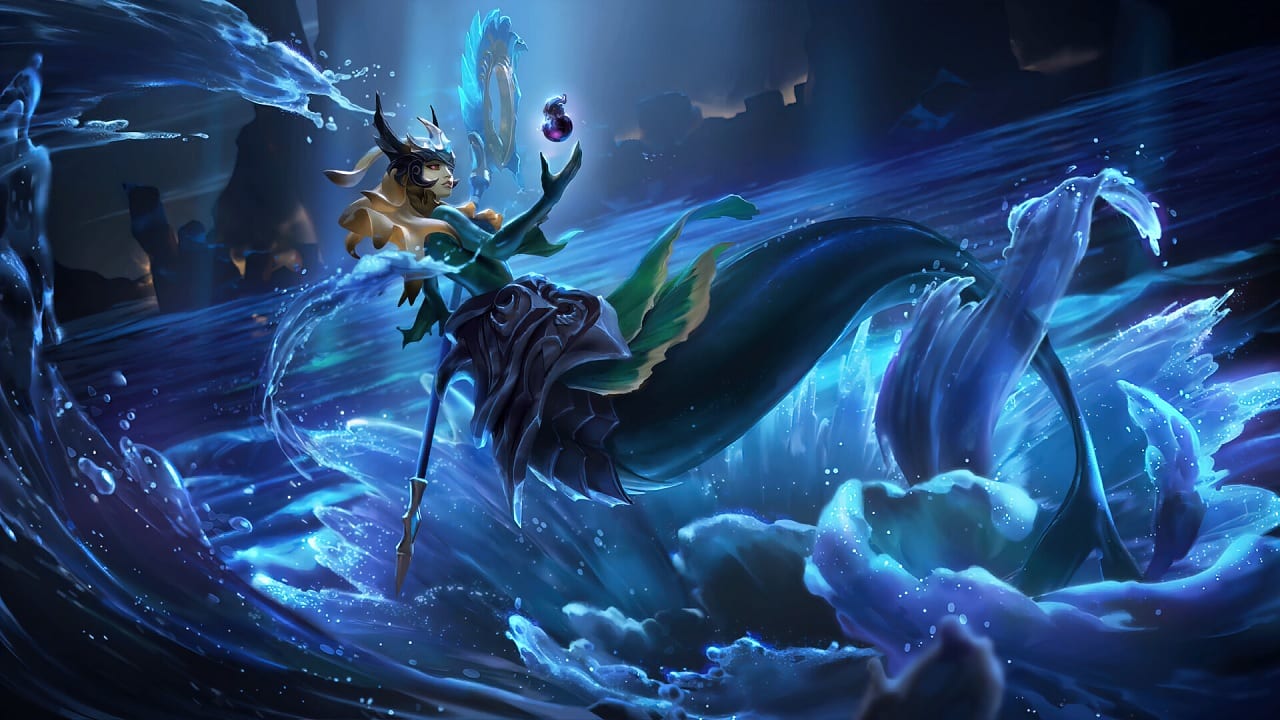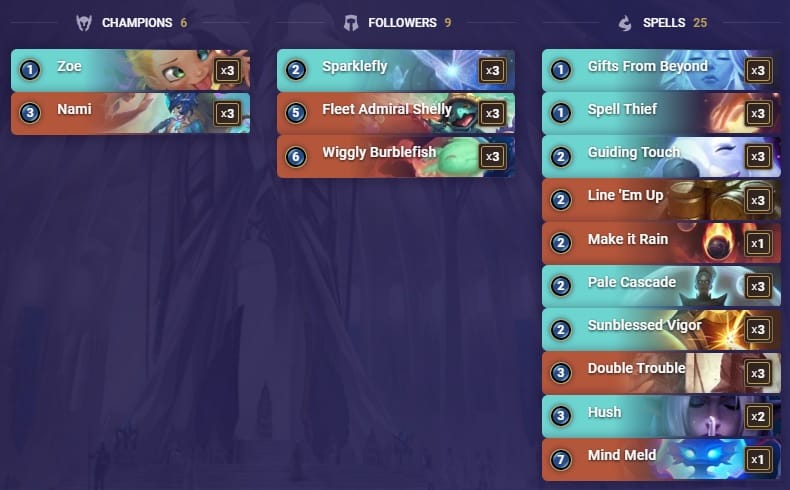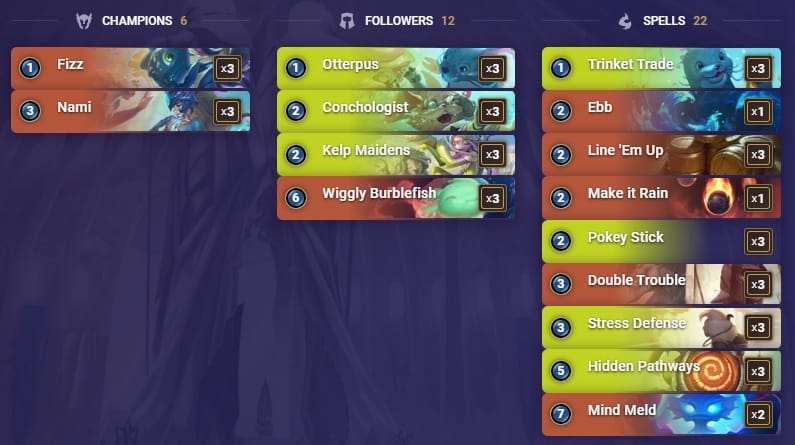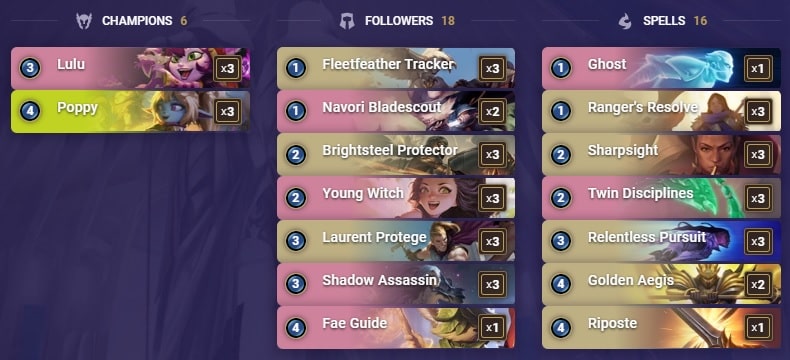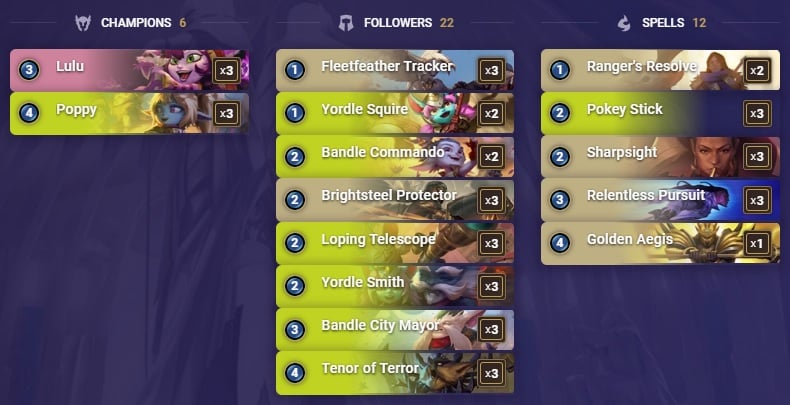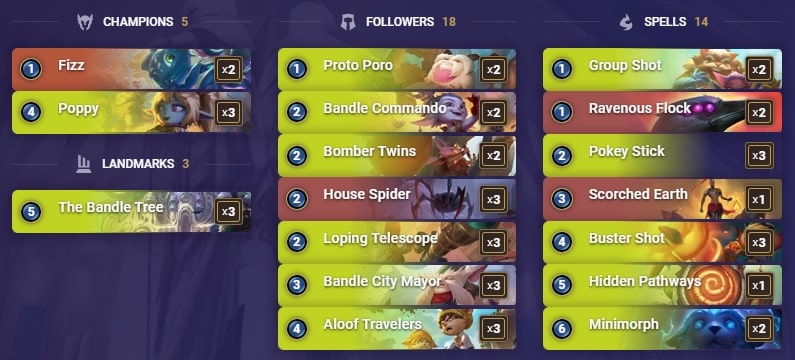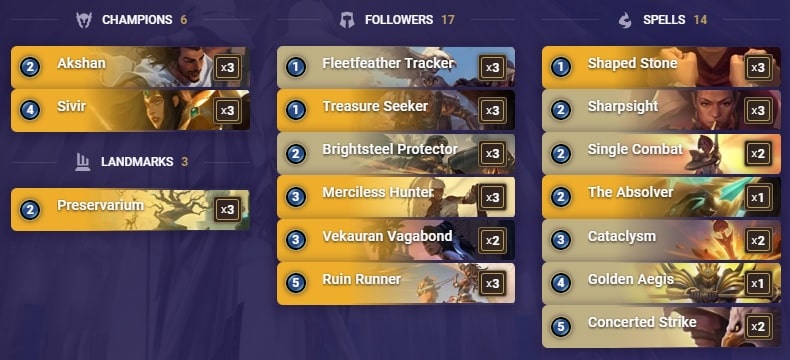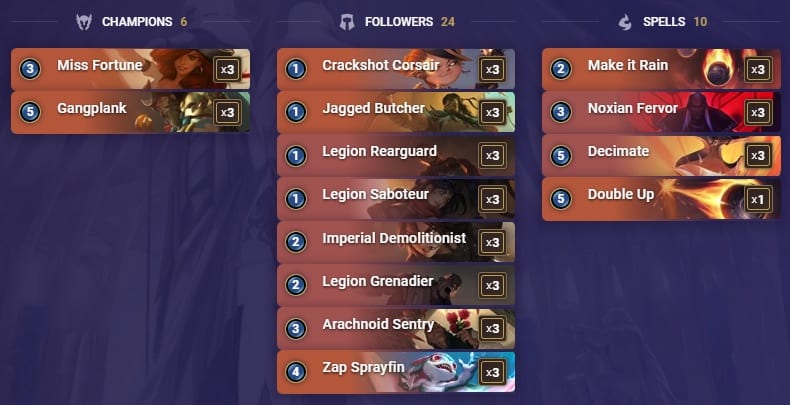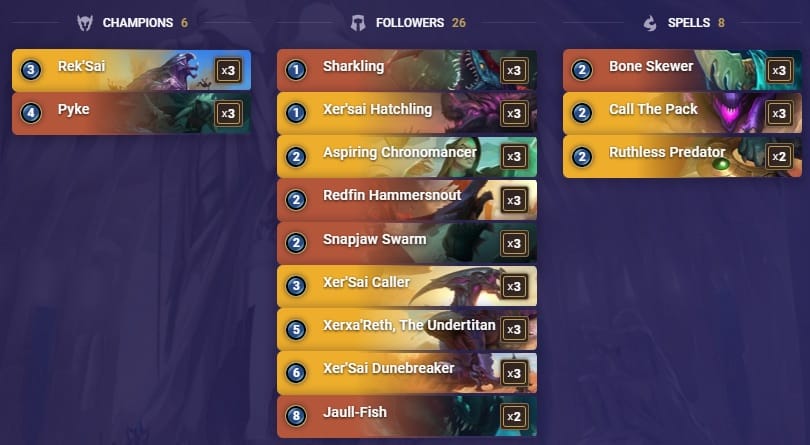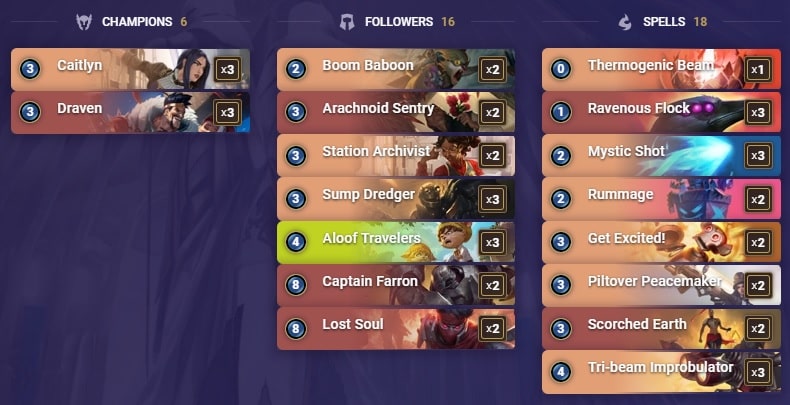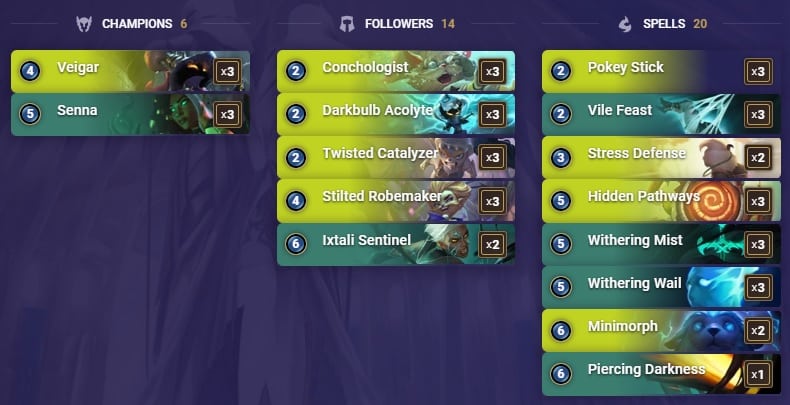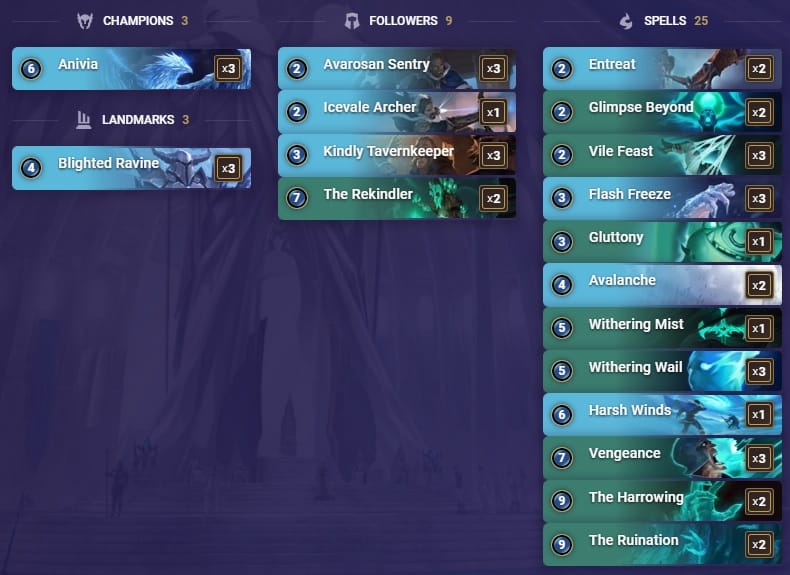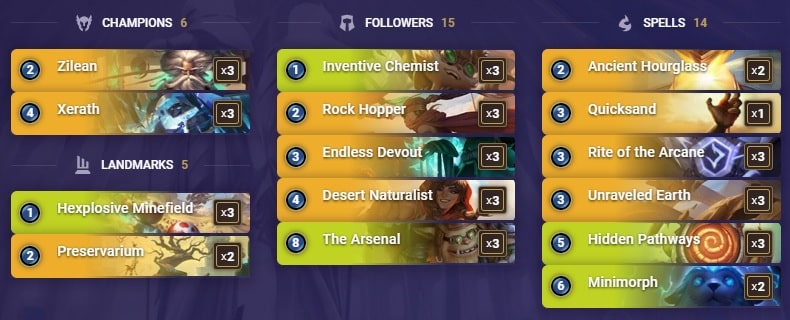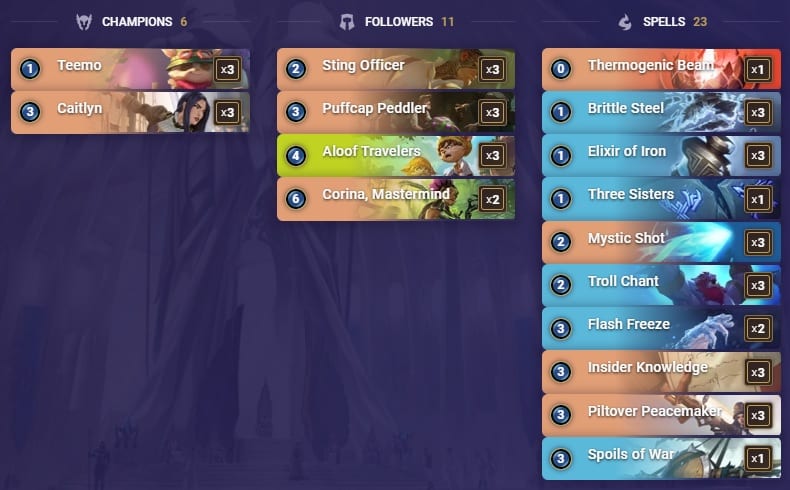Welcome to TLG’s latest meta snapshot for Legends of Runeterra, a series in which we give you our insight on the finest decks in the higher ranks of the ladder.
Every Monday, we discuss the decks that are part of the week’s meta and rate them on a scale of 1 to 5 stars. We also look at the evolution of said decks’ ratings across weeks and draw conclusions regarding the current state of the game, all of this so you can delve into your own ranked journey with a head start.
Nami has swam to the top of proceedings alongside Targon and Zoe - even above the might of Sion Discard. Lulu-Poppy continues to make Yordle-filled waves, while The Bandle Tree has found a region pairing, opting to take on the power of Noxian removals along with small blockers. Zilean-Xerath flashed, but the spark seems to be dying away.
If you have any questions, feel free to drop by our Discord. Best of luck on your climb!
Graphics: WellMax81
Editing: Wusubi, Sebodunum
Writers: Den, Ultraman, Othal

Zoe-Nami
CICQCAQGDAAQGBQRAECAMDQCAUDAKCYHAMEQSIZIFIZWFVYBAEAQGCKVAEBAEBRKFU
Difficulty: Moderate
If you want to relive the glory days when My Chemical Romance and pirate metal were walking hand in hand on the ladder of Runeterra fear not: you can now feel the same sensations, just with 89% less edginess. Aphelios and Twisted Fate are gracious losers and leave their place to the more feminine team of Zoe-Nami. It’s currently the best deck in the meta, due to its favored matchup into Sion Discard and the sheer power of free stats provided by Nami.
This list has a simple game plan and a lot of options. While you’ll usually just try and survive the early game to build a board of Elusives you can boost with Nami, this deck provides answers for most matchups. Against Aggro decks, you can use Sparklefly to get some free healing every turn. Against Midrange decks, abuse Nami to get the biggest units possible. You’ll suffer against control decks though, so stick to the plan and get to winning!
Leveling Nami is the most important task, so you’ll need to manage your spell mana carefully: if your reserve is full, you won’t gain more spell mana and thus will be stuck. But if you use only spell mana and don’t play creatures on the board, you’ll open yourself to threats and direct attacks while also slowing your win con, which is making the enemy Nexus explode.
Zoe is here to help you get early pressure, some low-cost spells to empty your spell mana reserve, and also some much-needed flexibility from her pool of Celestial Cards. Getting her to level-up isn’t necessary, so don’t focus on keeping her alive when Nami has a bigger impact on your strategy - alhough having a board full of Lifesteal Elusives thanks to Sparklefly is a joy known only to a few chosen ones. (Write-up by Othal)
Fizz-Nami
CQCQCAYGCEAQIBQOAECQMBICAIDBQLQHAUFAIBI2FAY2MAORAEAQCAQGFIBACAQGFUAQKBQG
In the first few days of the expansion, I remember Nami receiving some love, but still flying under the radar. It took two weeks since Bandle City was released for the game to be taken over by the buffing mermaid, who now possesses a target on her back, as her pairing with Zoe is currently the deck to beat.
This is the more discrete version, where Nami takes her services to Bandle and joins forces with Fizz, an Elusive champion who greatly appreciates receiving stat buffs. While Zoe-Nami is considered the better deck by many, I see a lot of upsides to playing this variation. While it sacrifices Targon’s healing potential, the deck is more efficient at the core of its strategy, as Bandle City adds more draw and spell generation to the archetype.
Fizz-Nami aims to use the Elusive synergy to bypass the opponent’s blockers and directly hit their Nexus with buffed-up units. There are two main phases to this plan, the first one focusing on spells and storing mana, which advances Nami’s level-up and reduces the cost of Wiggly Burblefish. The second being the pay-off, using cheap spells we generated along the way to buff our units in order to deliver the killing blow. (Write-up by den)
CECACAIDCQAQIBAQAQAQIJRHFU2AIBIDAECAMDIEAEAQIAIBAMBQ6AIDAQJACBIDBEBACAIDEMAQGAYN
Difficulty: Moderate
Sion Discard rose as one of the top tier decks almost immediately after the expansion, mostly countering Demacian archetypes. How is it faring after the nerfs, you ask? Despite facing less Akshan-Sivir and having to deal with a new challenger in Zoe-Nami, it remains one of the top contenders, with some adaptation to the rest of the field.
The list gives you many options. It can play as an Aggro deck, dealing a lot of damage on Turn 1 and 3, before finishing off the opponent with Get Excited! or Mystic Shot. It can also play slower, aiming to keep building up pressure until Sion reaches the board to seal the deal.
But those options aren’t mutually exclusive, and you can use both in the same game! It’s even what you usually aim for, forcing the opponent to go to great lengths to protect themselves from the early aggression, while still retaining tempo and removals to deal with Sion. Even if they do all this, they still have to win before you draw another Sion.
It’s a deck that looks easy on paper, but is in reality difficult to master. The fact that it has a lot of potential for techs, plays and alternative win cons makes it likely to have serious longevity in the top tiers. (Write-up by Ultraman)

Ionia splash
CEDACAQAA4AQGAAOAECQUKICAEBAYOICAMBAECQEAEAASCYVDUBACAICCEAQIAACAMAQCAQWAEBQEAYBAEACK
Difficulty: Easy
Although it hasn’t reached Tier 1 yet, Lulu-Poppy is a duo that has been very stable in the meta since Bandle City has arrived. Currently, you might see iterations of the Ionia deck using Zed instead of Lulu with some heavy Elusive packages, which is a more aggressive and punishing take on the archetype.
When Sion Discard was at the peak of its popularity, Lulu-Poppy couldn’t really shine. The deck lacked some sustainability to fight against the other explosive early game decks, eventually running out of steam. However, now that Nami decks are on the rise to counter Sion, the environment might be perfect for Lulu-Poppy to reach their full potential.
We’re including two different variations of the deck, splashing Ionia and Bandle City as the supporting regions. Although both lists rely on the same base concepts (namely, developing the board with a numbers approach and punishing opponents who can’t keep up through Rallies), there are some differences in the way they apply pressure.
The Ionian version relies on a better survivability for the key pieces, with the addition of Twin Disciplines and Elusive keywords helping Lulu and Poppy stay alive. The deck feels great when we draw our champions and keep them healthy. A flipped Poppy, for example, will more often than not win the game for us. (Write-up by den)
Bandle splash
CECACAYABYAQGAQCAMAQACIVDUDAKCRJMB2KMANPAHVQCAQBAIAAOAQFBKIQDJYBAEAQIAAC
The Bandle City side of things isn’t so keen on protecting its soldiers. Instead, the region relies on generating a ton of them to keep the opponent on their toes. By extension, the champions aren’t as protected as in the Ionia version. However, Bandle City makes up for this by having dangerous units. For example, an unanswered Bandle City Mayor can win you the game.
Overall, I would consider the Ionia list to be more well-rounded currently, but the Bandle deck has the upside of being better against removal-based decks, as it can create cards and delay the point where the pressure would let up.
CQBACAIDG4DQKCRJOSCADGABUYA26AOCAEBQCAQGFYAQEAYJAUCQUANAAGTQDQABYYAQEAIDAMGQCBIKDI
The Bandle Tree has been experimented with a lot since the expansion release. Many players can see the potential of the card, but there doesn’t seem to be a solid consensus on what the best 40 cards are for the deck. For now, it looks like at least one question has been solved: Noxus is the best region to pair with Bandle City for this purpose.
Noxus is the better choice over Bilgewater due to its access to removals. Ravenous Flock is extremely easy to activate in a deck that has the most small blockers to date and Scorched Earth wins the mirror match by destroying the opponent’s landmark, while acting as removal in other matchups.
The other thing Noxus has in its locker is House Spider. This simple 2-drop was quickly identified as a highly synergistic card with the archetype. It not only summons two regions for The Bandle Tree (the 1/1 Spiderling being a Shadow Isles unit), but also gives more targets for Poppy to buff and can help set up the Noxus-based removal mentioned earlier.
Compared to the previous iterations, the list now has more interaction with the opponent, while still possessing the high-roll potential of a Bandle City Mayor or a Poppy pressuring the opponent for a lot of damage. This more balanced take on the deck fares better in a meta that tends to favor pressure instead of control decks.
The switch towards Nami decks could be an issue for The Bandle Tree, even with Noxus helping in the matchup. It might be necessary to wait for a more defensive environment to see this deck rise atop the rankings. Until then, let’s consider it a nice middle of the pack deck that, like Tahm-Soraka, is based around an enjoyably different win condition through its landmark. (Write-up by den)
CMBQCAYABYBACAAJDUDQIBYNCQ3DOXLHQIAQIAIBAANACAQAAEAQIAADAECAPAABAIAQIAACAECAPCQB
Difficulty: Moderate
Even after its nerf, Akshan-Sivir is still a reliable deck. While its staying power took a hit, its lethality is unchanged. It has fallen down from OP tier, but it could still be a staple for any player trying to climb in a ladder where Sion is less prevalent.
Shurima/Demacia is an incredibly potent pairing, with combat tricks and removals aplenty to deal with backrow units like Azir, Nami or Ava Achiever. While you may not have as many buffs readily available as in the Ionia version, it’s compensated by the number of challenges you can issue via Fleetfeather Tracker, Merciless Hunter or even Cataclysm. Sharpsight is also handy in a meta bristling with Elusives like Teemo or Fizz.
The game plan is simple: to crush your enemies and to hear the lamentation of their women. Everything in your deck is a threat that your opponent won’t be able to value trade with thanks to your Challengers and combat tricks, and each piece of damage you deal goes towards leveling-up Sivir.
Use Golden Aegis wisely, and remember that Cataclysm procs an Attack and not a Strike, so damage from Overwhelm works! Akshan may look a bit out of place, but he’s an incredible value tool, providing you with a trigger for Shaped Stone while acting as a draw engine and a Quick-Attack threat.
Any unit you put on the board should stick, and when paired with a leveled-up Sivir... let’s just say that many Surrender buttons will be mistreated on this day. (Write-up by Othal)
CICACAQBAIAQGBQIAECAMCQIAIDAWFBAEETC2OR4AIAQIAIJAIBAMAQSAEAQCAIH
Difficulty: Moderate
GP-Sejuani plays the rhythm game like no one else! Try to deal damage every turn to grant your champions an early level-up, and watch those amazing abilities force your opponents to overreact. Then, punish them for doing so with a good amount of draws and some removals to deal with their threats.
Finish the game with The Dreadway and your multiple options: direct damage, board control, Overwhelm units or just... hitting. Hard. The deck is entirely based around the champions’ abilities, so you need to level them quickly. You might also want to keep them in your opening hand, as long as you already have some options for Turn 1/2.
It’s simple - without your champions, you don’t have a win condition. This is because the deck is built around the Overwhelm damage you get from them, while also preventing value trading. Warning Shot can act as two things: either as a way to activate your win cons or as a sneaky instant kill when your opponent doesn’t expect it. (Write-up by Ultraman)
CIBQEAQDAMCAKAIDAIGCKKBOAYBAMFRAEYWTUPAAAEAQEBQ7
Difficulty: Easy
Zoe-Nami is usually weak only during the first 3 turns, making it hard for most decks to take advantage of them... Most decks, but not this one! The Pirates’ early game is its best weapon, with no less than 12 plays for Turn 1. This allows you to deal a lot of damage to the passive Zoe-Nami deck.
Now, outside of that matchup, the list struggles a bit, with a lot of 50/50 matchups against other Aggro decks and a lot of bad matchups into Midrange decks. Pirates have a similar curve, but tire themselves out faster.
As can be discovered through therapy, quite often our greatest strength is also our deepest weakness. Pirates follow this logic. With its extremely low curve, you end up emptying your hand rapidly. This can be good for pressure, but also means you run out of options after a few turns. At least the games are fast when you know the outcome by Turn 3.
Yet, despite that glaring weakness, you might want to stay in the game if you don’t have a fantastic opening. Most decks lack healing, so Decimate and a flipped Gangplank are top targets for closing out an otherwise lost game. (Write-up by Ultraman)
CMBAKBAGAEBAGBIPA4CAOAITCZAUISSQAIAQIBQHAECAORIA
Difficulty: Moderate
While not as popular as when they were released, Lurkers are where they’re comfortable: under the radar and ready to strike. They have a good win rate against Nami, which is only fair seeing as we all know who eats who in a shark versus fish situation.
The most efficient lists moved away from the OTK combo approach that was prevalent in the previous meta and turned the deck into an Aggro one. The high-roll and Predict packages were toned down in favor of a more “straight-in-your-face” build. After all, you cannot miss your Lurks if your deck is full of Lurkers.
Your followers have lower-than-efficient statlines, so you’ll need to be clever in your attack timings and use Snapjaw Swarm to make sure you proc as many boosts as possible. Sometimes, giving your opponent a value trade is worth it, as it might allow you to gain +26 Attack between all units while helping Death from Below go above the HP threshold of a backline champion. You might even get a Rek’Sai proc and win the trade anyway.
Pyke is still one of the best cards in the deck, even more so in his spell form - but that shouldn’t prevent you from playing him, attacking, and putting him back in with a well-timed Bone Skewer. You can even get two of them in if you play one and use Death from Below to summon another.
Just imagine the power! Every piece of damage you deal is a step closer to his level-up, which essentially means destroying the whole enemy board with just 4 mana, so you can be greedy and go all-in without remorse. That’s in-character anyway.
Even if the deck is played as an Aggro one, don’t hesitate to slow down and build a board against the more resilient opponents, attacking with the less valuable units in your hand to proc Lurks, creating value with Call the Pack. You’ll have several ways of swinging the tempo back in your favor via a Jaull-Fish or a flipped Pyke ready to clear the enemy threats. (Write-up by Othal)
Caitlyn-Draven
CQDACAIDCQAQEAYJAEBQIEIBAUFJQAIBAUCAMAQBAQTDIBQBAMBQ2AIEAQIACBIDBEBACAZOGMBACBABE4BAKBAMBUAQCAIEDM
Difficulty: Moderate
Caitlyn-Draven came into the meta strong right after the World’s Qualifications, as it was a part of a lot of the line-ups of those who succeeded there. That being said, tournament and ladder are two different exercises, and the deck has been disappointing so far in the latter.
With a win rate below 50% and a sad matchup sheet, the list feels like it sacrificed the original core to satisfy Lost Soul’s needs, making it a top priority in the mulligan phase and forcing you to make a choice between Lost Soul and Tri-beam Improbulator.
That’s the deck’s main problem. The two dynamics don’t mesh well together, ending up with the player often having either a good hand for Lost Soul or a good hand for Tri-beam. The former lacks win conditions and the latter runs out of cards to play. The balance is hard to find, and it might just be that the deck is unreliable, rather than your mulligans. (Write-up by Ultraman)

CQCACBAFHAAQKBIJAIAQKHJIA4CQUGRRHFOV4YVGAEBACBIFBABAKCQB2EAQCAIFAUBQ
Difficulty: Easy
Veigar is a fan favorite who most people truly want to see put in the work - but he struggles to live up to these expectations in this incredibly tough meta. Although he can swat aside unrefined decks that forget to pressure him, his abysmal lack of tempo makes him a perfect target for fast, bulky Midrange lists - which just so happens to be most of the top tier decks right now.
He also lacks reactive abilities. Darkness is useful as removal, but it’s proactive removal (until Senna comes online), which can be sidestepped by Recall spells like Lead and Follow or combat tricks (Sharpsight, Troll Chant, Shaped Stone). Your best set-up is, surprisingly, not having Veigar on board, but Senna.
Her base form speeds up damage and spells from Slow to Fast and her level-up reduces their cost by 1. As such, you can finally gain tempo on your opponent and answer their threats. Finally, the fact that she creates multiple versions of Darkness helps to level-up Veigar and keeps your hand full with the now-reactive removals!
A common tech choice is to kick Stilted Robemaker for Aloof Travelers. This gives you more hand disruption but less synergy. This might be a meta call, as some threats are too hard to answer once on the board (and much better when visibly discarded from the opponent’s hand). (Write-up by Ultraman)
CEBQCBABBYBQCBIBDUUAIAIBAEBRQMQCAIAQCFA5AQAQKAYPCQYQGAIDAUJACBAFHABACAILFI
Anivia is long past her prime, yet keeps coming back when the occasion presents itself. Currently, the Shadow Isles and Freljord pairing isn’t great, as the meta features a ton of decks with big refill capacities. The presence of Sion also means The Ruination won’t be too useful, as his final form will return after that spell resolves.
What the list has going for it, though, is a heavy Freeze package. This is something that’s flying under the radar at the moment, but actually works quite well. Freezing helps deal with Sion without activating his Last Breath condition, it delays a huge Zoe or Sparklefly that has been beefed-up by Nami, or can prevent Poppy’s ability to buff the rest of the units on the board.
However, the upsides to the Freeze package aren’t enough for Anivia to be considered a serious contender currently, because the Freezes only buy you time; the problems keep on coming. Also, the list almost auto-loses to The Bandle Tree or Rally decks, which are keeping it in check way too easily with the way they operate. As such, Anivia is looking like a counter deck that needs to pick its battles, but isn’t fit to compete in a meta with many possibilities. (Write-up by den)
CQBQGBIHA4FQ4BAEA4SSMJ2ZAQCQUBQ2DNEQEAIFBIAQEBAHBVGACAIEA5WQ
Difficulty: Moderate
This deck came out of nowhere to shine briefly, but its time might have already passed. Thanks to the surprise value, it allowed some people to climb, giving hope to all the Xerath mains out there. But let’s be honest, the deck is just too slow. In every single aspect. It struggles against most decks with high proactivity and doesn’t have access to the best removals.
And even if you draw the very limited removals at your disposal, they’re easily dealt with by virtually any combat trick out there. Xerath’s level-up is impressive, but the condition is too hard to fulfill. Destroying 4 landmarks takes a lot of time, especially when we want to put him on the board as fast as possible in order to benefit from his level 1 ability.
In the end, the deck’s sole win condition is The Arsenal, and having to wait until Turn 8 or more to win a game is way too slow to work effectively in the current meta. (Write-up by Ultraman)
CECQCAYBAIAQKCUYAEBACAIEDYBQCBAIDE2AIBIEAIDASDICAEAQCAIBAUCA4AQBAECBWAQEAEFBA
Difficulty: Moderate
Teemo has found a trap buddy, and it might be enough to start taking the archetype seriously. First, it makes a difference in the way the deck operates, as the Flashbomb Trap helps deal with the opponent’s board, punishing swarm strategies - something the deck struggled with in the past.
Secondly, Caitlyn and Corina, Mastermind give the deck a new dynamic in terms of damage, greatly reducing the need to make the opponent draw, which could offer them additional options. Instead, the deck now tries to stall the game while shuffling the traps and then activate them through Corina for a huge burst of damage.
Your opponent’s card draw is more controlled and instead of Hexcore Foundry, we include the new Insider Knowledge spell as another Flashbomb activator, helping to reduce the opposing aggression in emergency cases. Otherwise, it can always activate some Puffcaps later on, or simply serve as refill if we’re lacking defensive options.
This deck is rated so low mostly due to the inherent randomness of the traps mechanic. When everything clicks and Caitlyn levels-up or Corina triggers tons of Puffcaps, we could rate it at 5 stars. The problem is that when the traps aren’t in our favor, we’re stalling while doing nothing and eventually we get outpaced by our opponent.
With more refinement, the deck could end up being relevant in the long run. This would make a welcome change from the infuriating “counter” tag it has been labeled with for a long time now, only shining against control decks. (Write-up by den)

